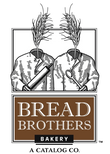Bread Baking Basics, pt. 1
We'll cut straight to the heart of today's message: baking bread is not as hard as you might think.
That's right. The whole process is surprisingly simple, and you can do it at home without needing fancy equipment or an extensive knowledge of baking. Sure, a perfect loaf will take practice, but your very first loaf will probably turn out better than you expected. It'll certainly be a whole lot tastier - and healthier - than store bought bread, and it'll be a solid foundation as you start to adjust your recipe and craft it into exactly what you want.
This series is divided into four articles. Today, we'll start off with an introduction into bread baking basics. Over the next three chapters, we'll share more details along with some tips and tricks you can experiment with as you keep practicing. At the end, we'll include a recipe to help you kick off your bread baking journey.
Equipment
You may be wondering what equipment you'll need before you get started. The very least you'll need is a mixing bowl and a bread pan. We also recommend a wooden spoon. If you plan on making bread more than once or twice, we also recommend a stand mixer with a dough hook attachment. We prefer Bosch Universal mixers, but there's a lot of information about kitchen mixers and you can choose whichever one fits your preference and budget.
Getting Started!
Okay! You've got your equipment and you're ready to get started. The first thing you'll probably want is a recipe. Different kinds of bread require different ingredients (more on that later in the tips and tricks), but the simplest bread boils down to 4 core ingredients: flour, water, salt, and yeast. Flour and water make up the bulk of your dough. Salt adds flavor. Yeast makes it rise.
If you're hearing alarm bells right now, don't worry! Many new bakers are intimidated by the idea of using yeast, so let's demystify yeast right now. Yeast is actually a single-celled organism. When you add it to your dough, the yeast microbes feed off the natural sugar in the flour, and produce carbon dioxide as a byproduct. This release of gas is what makes bread rise, a process known as leavening.
Now that you've got your basic ingredients, let's move on to an overview of the whole process:
- Your ingredients will be mixed together to form the dough.
- The dough will sit and rise.
- After the dough rises, you put it in the oven and bake it into a loaf of bread.
Congratulations! You made it through your first bread baking lesson. Hopefully you're feeling excited about this wonderful journey. Next time, we'll dive a little deeper into understanding ingredients and their roles, and how to choose the right ingredients for your bread.


Leave a comment